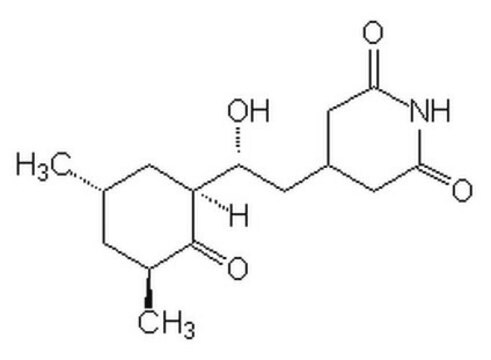239765
Cycloheximide
InSolution, 100 mg/mL in DMSO, Suitable for cell culture
Sinónimos:
InSolution Cycloheximide
About This Item
Productos recomendados
Nivel de calidad
Formulario
solution
fabricante / nombre comercial
Calbiochem®
concentración
100 mg/mL in DMSO
solubilidad
DMSO: soluble
temp. de almacenamiento
2-8°C
InChI
1S/C15H23NO4/c1-8-3-9(2)15(20)11(4-8)12(17)5-10-6-13(18)16-14(19)7-10/h8-12,17H,3-7H2,1-2H3,(H,16,18,19)/t8-,9-,11-,12+/m0/s1
Clave InChI
YPHMISFOHDHNIV-FSZOTQKASA-N
Descripción general
Acciones bioquímicas o fisiológicas
hFKBP12
Envase
Advertencia
Forma física
Reconstitución
Otras notas
Lu, Q. and Mellgreen,R.L. 1996. Arch. Biochem. Biophys.334, 175.
Chow, S.C., et al. 1995. Exp. Cell Res.216, 149.
Waring, P. 1990. J. Biol. Chem.265, 14476.
Obrig, T.G., et al. 1971. J. Biol. Chem.246, 174.
Pestka, S. 1971. Annu. Rev. Microbiol.25, 487.
Información legal
Palabra de señalización
Danger
Frases de peligro
Consejos de prudencia
Clasificaciones de peligro
Acute Tox. 3 Oral - Aquatic Chronic 3 - Muta. 2 - Repr. 1B
Código de clase de almacenamiento
6.1C - Combustible acute toxic Cat.3 / toxic compounds or compounds which causing chronic effects
Clase de riesgo para el agua (WGK)
WGK 3
Certificados de análisis (COA)
Busque Certificados de análisis (COA) introduciendo el número de lote del producto. Los números de lote se encuentran en la etiqueta del producto después de las palabras «Lot» o «Batch»
¿Ya tiene este producto?
Encuentre la documentación para los productos que ha comprado recientemente en la Biblioteca de documentos.
Los clientes también vieron
Nuestro equipo de científicos tiene experiencia en todas las áreas de investigación: Ciencias de la vida, Ciencia de los materiales, Síntesis química, Cromatografía, Analítica y muchas otras.
Póngase en contacto con el Servicio técnico








